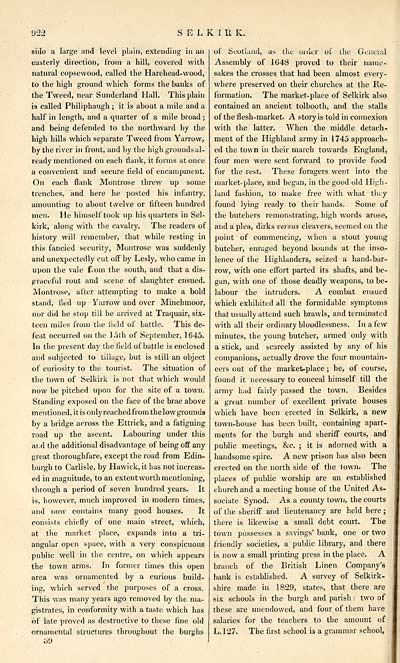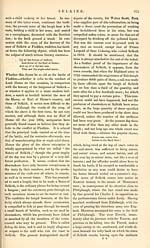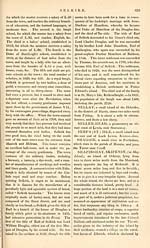Gazetteer of Scotland > Volume 2
(442) Page 922
Download files
Complete book:
Individual page:
Thumbnail gallery: Grid view | List view

922
L K I U K.
side a large and level plain, extending in an
easterly direction, from a hill, covered with
natural copsewood, called the Harehead-wood,
to the high ground which forms the banks of
the Tweed, near Sunderland Hall. This plain
is called Philiphaugh ; it is about a mile and a
half in length, and a quarter of a mile broad ;
and being defended to the northward by the
high hills which separate Tweed from Yarrow,
by the river in front, and by the high grounds al-
ready mentioned on each flank, it forms at once
a convenient and secure field of encampment.
On each flank Montrose threw up some
trenches, and here he posted his infantry,
amounting to about twelve or fifteen hundred
men. He himself took up his quarters in Sel-
kirk, along with the cavalry. The readers of
history will remember, that while resting in
this fancied security, Montrose was suddenly
and unexpectedly cut off by Lesly, who came in
upon the vale from the south, and that a dis-
graceful rout and scene of slaughter ensued.
Montrose, after attempting to make a bold
stand, fled up Yarrow and over Minchmoor,
nor did he stop till he arrived at Traquair, six-
teen miles from the field of battle. This de-
feat occurred on the 15th of September, 1645.
In the present day the field of battle is enclosed
and subjected to tillage, but is still an object
of curiosity to the tourist. The situation of
the town of Selkirk is not that which would
now be pitched upon for the site of a town.
Standing exposed on the face of the brae above
mentioned, it is only reached from the low grounds
by a bridge across the Ettrick, and a fatiguing
road up the ascent. Labouring under this
ai;d the additional disadvantage of being off any
great thoroughfare, except the road from Edin-
burgh to Carlisle, by Hawick, it has not increas-
ed in magnitude, to an extent worth mentioning,
through a period of seven hundred years. It
is, however, much improved in modern times,
and now contains many good houses. It
consists chiefly of one main street, which,
at the market place, expands into a tri-
angular open space, with a very conspicuous
public well in the centre, on which appears
the town arms. In former times this open
area was ornamented by a curious build-
ing, which served the purposes of a cross.
This was many years ago removed by the ma-
gistrates, in conformity with a taste which has
of late proved as destructive to these fine old
ornamental structures throughout the burghs
^9
of Scotland, as the order of die General
Assembly of 1648 proved to their name-
sakes the crosses that had been almost every-
where preserved on their churches at the Re-
formation. The market-place of Selkirk also
contained an ancient tolbooth, and the stalls
of the flesh-market. A story is told in connexion,
with the latter. When the middle detach-
ment of the Highland army in 1745 approach-
ed the town in their march towards England,
four men were sent forward to provide food
for the rest. These foragers went into the
market-place, and began, in the good old High-
land fashion, to make free with what they
found lying ready to their hands. Some of
the butchers remonstrating, high words arose,
and a plea, dirks versus cleavers, seemed on the
point of commencing, when a stout young
butcher, enraged beyond bounds at the inso-
lence of the Highlanders, seized a hand-bar-
row, with one effort parted its shafts, and be-
gan, with one of those deadly weapons, to be-
labour the intruders. A combat ensued
which exhibited all the formidable symptoms
that usually attend such brawls, and terminated
with all their ordinary bloodlessness. In a few
minutes, the young butcher, armed only with
a stick, and scarcely assisted by any of his
companions, actually drove the four mountain-
eers out of the market-place ; he, of course,
found it necessary to conceal himself till the
army had fairly passed the town. Besides
a great number of excellent private houses
which have been erected in Selkirk, a new
town-house has been built, containing apart-
ments for the burgh and sheriff courts, and'
public meetings, &c. ; it is adorned with a
handsome spire. A new prison has also been
erected on the north side of the town. The
places of public worship are an established
church and a meeting house of the United As-
sociate Synod. As a county town, the courts
of the sheriff and lieutenancy are held here ;
there is likewise a small debt court. The
town possesses a savings' bank, one or two
fi-ie ndly societies, a public library, and there
is now a small printing press in the place. A
branch of the British Linen Company's
bank is established. A survey of Selkirk-
shire made in 1829, states, that there are
six schools in the burgh and parish : two of
these are unendowed, and four of them have
salaries for the teachers to the amount of
L. 127. The first school is a grammar school,
L K I U K.
side a large and level plain, extending in an
easterly direction, from a hill, covered with
natural copsewood, called the Harehead-wood,
to the high ground which forms the banks of
the Tweed, near Sunderland Hall. This plain
is called Philiphaugh ; it is about a mile and a
half in length, and a quarter of a mile broad ;
and being defended to the northward by the
high hills which separate Tweed from Yarrow,
by the river in front, and by the high grounds al-
ready mentioned on each flank, it forms at once
a convenient and secure field of encampment.
On each flank Montrose threw up some
trenches, and here he posted his infantry,
amounting to about twelve or fifteen hundred
men. He himself took up his quarters in Sel-
kirk, along with the cavalry. The readers of
history will remember, that while resting in
this fancied security, Montrose was suddenly
and unexpectedly cut off by Lesly, who came in
upon the vale from the south, and that a dis-
graceful rout and scene of slaughter ensued.
Montrose, after attempting to make a bold
stand, fled up Yarrow and over Minchmoor,
nor did he stop till he arrived at Traquair, six-
teen miles from the field of battle. This de-
feat occurred on the 15th of September, 1645.
In the present day the field of battle is enclosed
and subjected to tillage, but is still an object
of curiosity to the tourist. The situation of
the town of Selkirk is not that which would
now be pitched upon for the site of a town.
Standing exposed on the face of the brae above
mentioned, it is only reached from the low grounds
by a bridge across the Ettrick, and a fatiguing
road up the ascent. Labouring under this
ai;d the additional disadvantage of being off any
great thoroughfare, except the road from Edin-
burgh to Carlisle, by Hawick, it has not increas-
ed in magnitude, to an extent worth mentioning,
through a period of seven hundred years. It
is, however, much improved in modern times,
and now contains many good houses. It
consists chiefly of one main street, which,
at the market place, expands into a tri-
angular open space, with a very conspicuous
public well in the centre, on which appears
the town arms. In former times this open
area was ornamented by a curious build-
ing, which served the purposes of a cross.
This was many years ago removed by the ma-
gistrates, in conformity with a taste which has
of late proved as destructive to these fine old
ornamental structures throughout the burghs
^9
of Scotland, as the order of die General
Assembly of 1648 proved to their name-
sakes the crosses that had been almost every-
where preserved on their churches at the Re-
formation. The market-place of Selkirk also
contained an ancient tolbooth, and the stalls
of the flesh-market. A story is told in connexion,
with the latter. When the middle detach-
ment of the Highland army in 1745 approach-
ed the town in their march towards England,
four men were sent forward to provide food
for the rest. These foragers went into the
market-place, and began, in the good old High-
land fashion, to make free with what they
found lying ready to their hands. Some of
the butchers remonstrating, high words arose,
and a plea, dirks versus cleavers, seemed on the
point of commencing, when a stout young
butcher, enraged beyond bounds at the inso-
lence of the Highlanders, seized a hand-bar-
row, with one effort parted its shafts, and be-
gan, with one of those deadly weapons, to be-
labour the intruders. A combat ensued
which exhibited all the formidable symptoms
that usually attend such brawls, and terminated
with all their ordinary bloodlessness. In a few
minutes, the young butcher, armed only with
a stick, and scarcely assisted by any of his
companions, actually drove the four mountain-
eers out of the market-place ; he, of course,
found it necessary to conceal himself till the
army had fairly passed the town. Besides
a great number of excellent private houses
which have been erected in Selkirk, a new
town-house has been built, containing apart-
ments for the burgh and sheriff courts, and'
public meetings, &c. ; it is adorned with a
handsome spire. A new prison has also been
erected on the north side of the town. The
places of public worship are an established
church and a meeting house of the United As-
sociate Synod. As a county town, the courts
of the sheriff and lieutenancy are held here ;
there is likewise a small debt court. The
town possesses a savings' bank, one or two
fi-ie ndly societies, a public library, and there
is now a small printing press in the place. A
branch of the British Linen Company's
bank is established. A survey of Selkirk-
shire made in 1829, states, that there are
six schools in the burgh and parish : two of
these are unendowed, and four of them have
salaries for the teachers to the amount of
L. 127. The first school is a grammar school,
Set display mode to: Large image | Transcription
Images and transcriptions on this page, including medium image downloads, may be used under the Creative Commons Attribution 4.0 International Licence unless otherwise stated. ![]()
| Gazetteers of Scotland, 1803-1901 > Gazetteer of Scotland > Volume 2 > (442) Page 922 |
|---|
| Permanent URL | https://digital.nls.uk/97436126 |
|---|
| Description | Volume II: Glenbanchor to Zetland. |
|---|---|
| Attribution and copyright: |
|
| Description | By Robert Chambers and William Chambers. Glasgow: Blackie & Son, 1838. 2 volumes. |
|---|---|
| Shelfmark | NF.1461.g.7 |
| Additional NLS resources: | |

